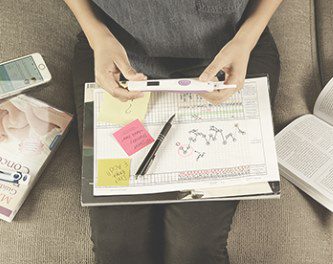Tracking your menstrual cycle
![]() How long is your menstrual cycle? Is your cycle between 28 and 35 days? Or is it so irregular that it can be hard to predict what day Auntie Flo will come calling?
How long is your menstrual cycle? Is your cycle between 28 and 35 days? Or is it so irregular that it can be hard to predict what day Auntie Flo will come calling?
Understanding and tracking your menstrual cycle is one of the key ways you can figure out when you are ovulating and releasing an egg that can be fertilized with your husband’s or partner’s sperm. This information will help you determine your fertile window, which is the optimal period when pregnancy can occur, usually six days before ovulation. Women who have a 28-day cycle, on average, ovulate on day 14, but ovulation can occur between days 11 and 21. Generally, ovulation occurs 14 days before the onset of your next menstrual cycle.
If you are attempting pregnancy, tracking your cycle is one of the first steps a doctor will recommend for taking charge of the conception process.
The fertile window
The most fertile time for a woman without any fertility problems to get pregnant is six days before ovulation. You also can get pregnant 12-24 hours after your egg has been released if sperm is present. It takes about six hours for sperm to reach the fallopian tube.
Bodily signals of ovulation
Cervical mucus and vaginal secretions are two important signs that ovulation is near. They start to increase five to six days before ovulation, peaking at two to three days before the egg is released. Cervical mucus becomes more transparent and ‘stretchier’ and has a consistency similar to egg whites, which helps sperm swim to the egg.
Some women experience a heightened sense of smell, breast tenderness, abdominal pain and, perhaps, increased libido or light spotting as their body gets ready to ovulate.
Ways to test for ovulation
They are a variety of ways to keep track of your period, to determine when you usually ovulate and to plan for having sexual intercourse. Here is a summary of some of the proven ways.
Ovulation calendar
Use an ovulation calendar to get a sense of how long your cycle is over several months. The American Pregnancy Association has an online ovulation calendar. (http://americanpregnancy.org/ovulation-calendar/)
Basal body temperature and cervical mucus (BBT) chart
Using a basal body thermometer, you should take your basal (resting) body temperature at around the same time each morning after you wake and before you eat, drink, sit up or have sex. At the same time, also note the characteristics of your cervical mucus as dry, sticky, like egg whites or on your period.
To help in this process, you can use a chart similar to what the Baby Center provides: https://www.babycenter.com/0_blank-bbt-chart_7069.bc
Urine test kits
An ovulation prediction kit (OPK) can help you determine when you are ready to ovulate. It will test your urine for luteinizing hormone (LH) and follicle-stimulating hormone (FSH), the two hormones that increase around 36 hours before ovulation when estrogen levels peak.
Most of these tests include several ‘pee’ sticks that should be used over the course of several days to detect, as accurately as possible, the LH surge. Overall, these tests are convenient and easy to use. There are basic kits as well as more sophisticated versions that keep track of past cycles and also provide digital responses.
There’s an app for that
If you want to track your cycle on your smartphone, there are many ‘apps’ for that. Over the last several years, savvy high-tech entrepreneurs have developed a variety of apps that collect personalized data about your cycle as well as your overall health. Though many are free for limited use, others charge fees. Advanced apps provide functions such as monitoring basal body temperature and measuring saliva and cervical mucus.
These low-cost and low-tech methods can help you predict when you should have sexual intercourse before ovulation occurs. Planned sex may not seem very sexy, but it can be very useful for getting pregnant when no other fertility issues are present.
References
http://americanpregnancy.org/getting-pregnant/getting-pregnant-after-ovulation/
https://www.mayoclinic.org/healthy-lifestyle/womens-health/in-depth/menstrual-cycle/art-20047186
https://en.wikipedia.org/wiki/Ovulation
https://medlineplus.gov/ency/article/007062.htm
https://www.thebump.com/a/best-ovulation-predictor-kits
https://www.fitpregnancy.com/pregnancy/getting-pregnant/best-fertility-apps
https://www.thebump.com/a/ovulation-symptoms-signs-of-ovulation

